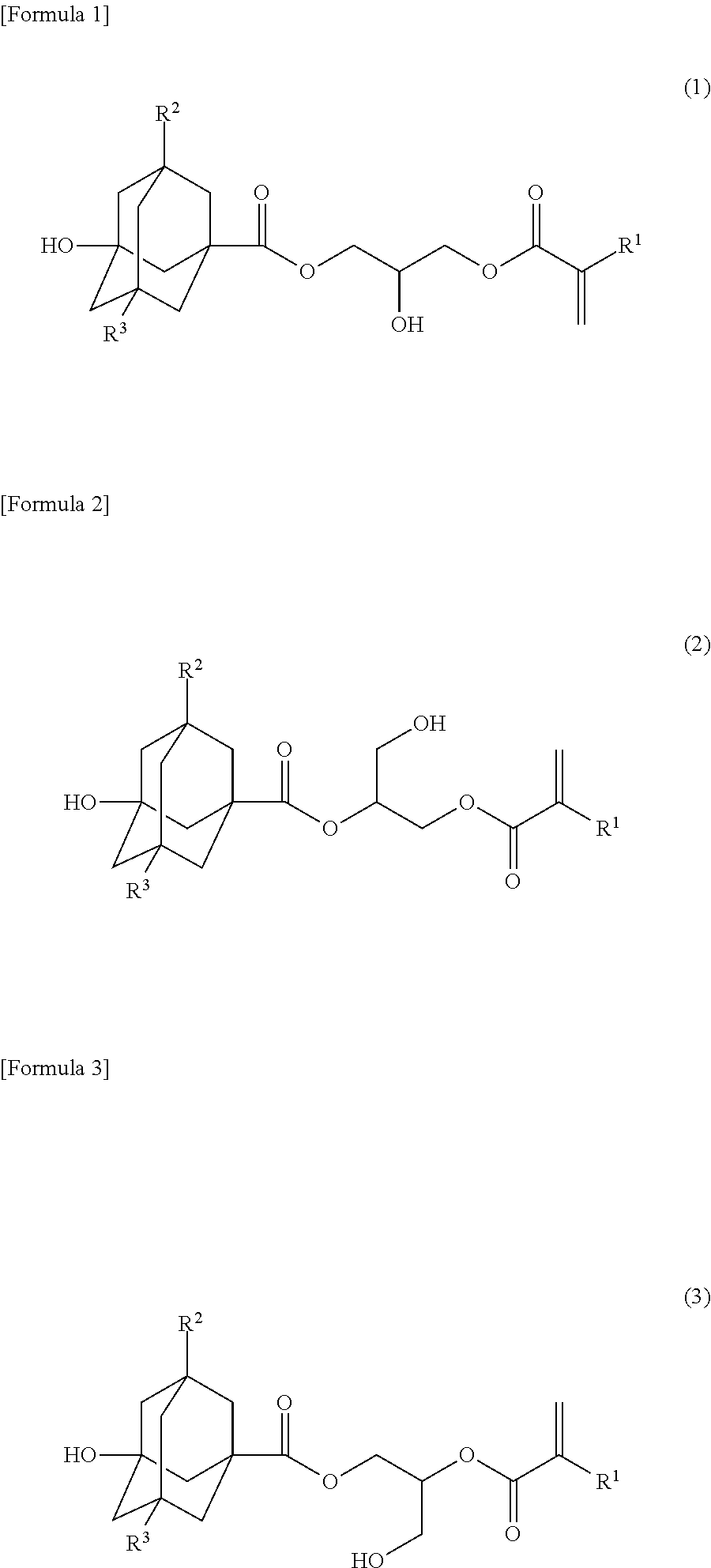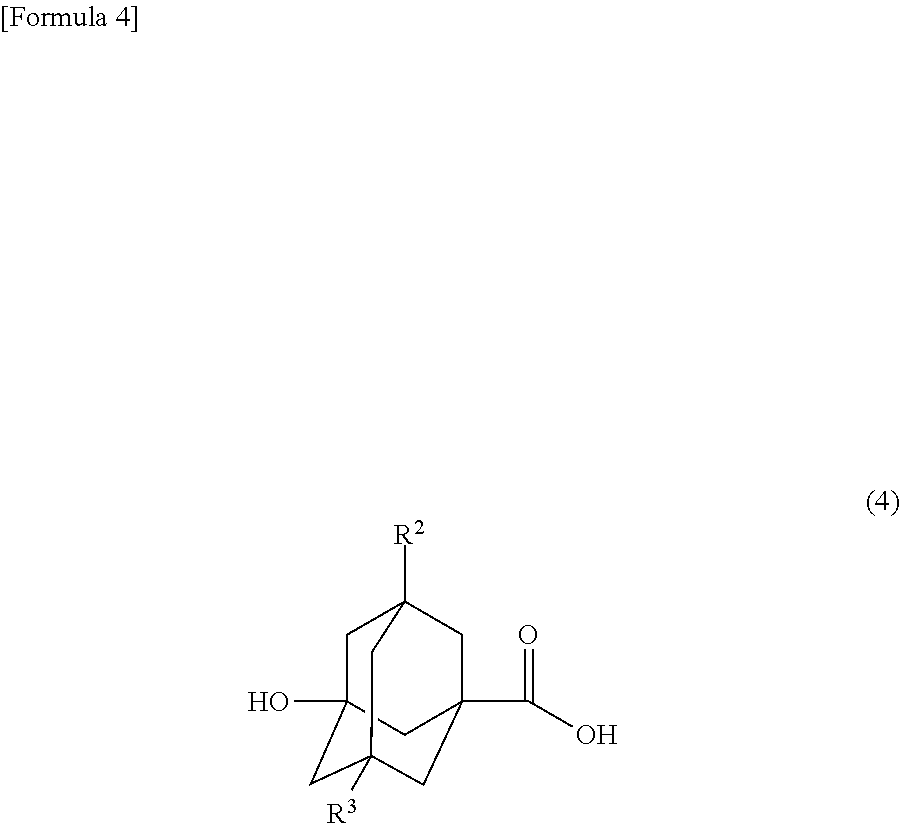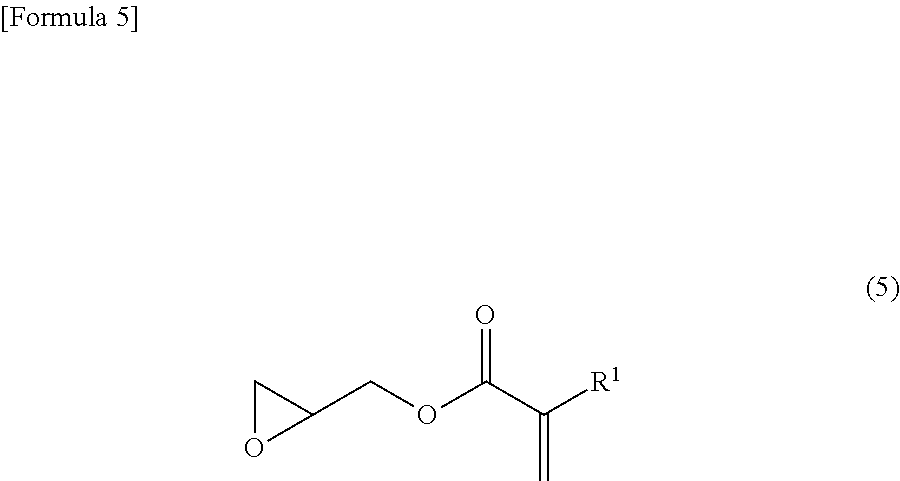Alicyclic ester compound, and (meth)acrylic copolymer and photosensitive resin composition containing same
a technology of alicyclic ester and acrylic copolymer, which is applied in the field of cycloaliphatic ester compounds, can solve the problems of reduced resolution and poor line edge roughness, and the single type of repeating unit cannot meet all of the properties including etching, so as to improve resolution and line edge roughness
- Summary
- Abstract
- Description
- Claims
- Application Information
AI Technical Summary
Benefits of technology
Problems solved by technology
Method used
Image
Examples
example 1
Preparation of methacryloyloxyhydroxypropyl 3-hydroxy-1-adamantanecarboxylate
[0083]Into a 1000 ml three-necked round-bottomed flask equipped with a stirrer, a thermometer and an air inlet, 3-hydroxy-1-adamantanecarboxylic acid (49.08 g, 0.25 mol), glycidyl methacrylate (31.98 g, 0.225 mol), tetramethylammonium chloride (2.74 g, 25 mmol), p-methoxyphenol (319.6 mg, 2.6 mmol) and dimethyl sulfoxide (250 g) were introduced and stirred at 90° C. for 5 hours under air blowing conditions. After completion of the reaction, chloroform (1000 g) was added to the reaction mixture and the organic layer was washed with 5% aqueous sodium chloride (1000 g), 5% aqueous sodium carbonate (1000 g), 1% aqueous sulfuric acid (1000 g) and then 5% aqueous sodium chloride (1000 g). The organic layer was collected and silica gel (25 g) was added thereto, followed by stirring for 1 hour. The silica gel was removed with a 5C filter paper and washed with chloroform (1000 g). To the collected chloroform solutio...
example 2
Preparation of methacryloyloxyhydroxypropyl 3-hydroxy-1-adamantanecarboxylate polymer
[0087]The mixture of 2-hydroxy-3-methacryloyloxypropyl 3-hydroxy-1-adamantanecarboxylate (i.e., a compound of formula (1)), 1-hydroxy-3-methacryloyloxypropan-2-yl 3-hydroxy-1-adamantanecarboxylate (i.e., a compound of formula (2)) and 3-hydroxy-2-methacryloyloxypropyl 3-hydroxy-1-adamantanecarboxylate (i.e., a compound of formula (3)) obtained in Example 1 (hereinafter referred to as monomer M; 3.05 g), 2-ethyl-2-methacryloyloxyadamantane (hereinafter referred to as monomer E; 4.47 g) used as a starting material of formula (9), α-methacryloyloxy-γ-butyrolactone (hereinafter referred to as monomer G; 3.07 g) used as a starting material of formula (12), and azobisisobutyronitrile (0.37 g) were dissolved in tetrahydrofuran (90 mL) and polymerized for 15 hours under a nitrogen atmosphere while maintaining the reaction temperature at 60° C. (the initial monomer ratio M / E / G=20 / 40 / 40 mol %). After polymeri...
example 3
[0088]100 parts by weight of the methacrylic copolymer A and 10 parts by weight of triphenylsulfonium nonafluorobutanesulfonate (TPS-109, Midori Kagaku Co., Ltd., Japan) were dissolved in an ethyl lactate solvent to give a copolymer concentration of 6.3% by weight, thereby preparing photosensitive resin composition C. After an antireflection coating (ARC-29, Nissan Chemical Industries, Ltd., Japan) was applied onto a silicon wafer, this photoresist resin composition was applied onto the antireflection coating by spin coating to thereby form a photosensitive layer of 100 nm thickness. After pre-exposure bake on a hot plate at a temperature of 90° C. for 60 seconds, the photosensitive layer was irradiated in a 80 nm half-pitch line and space pattern (10 lines) using an electron beam lithography system (ELS-7700, Elionix Inc., Japan), followed by post-exposure bake (PEB) at a given temperature for 90 seconds. Then, the photosensitive layer was developed for 60 seconds with 0.3 M aqueou...
PUM
| Property | Measurement | Unit |
|---|---|---|
| temperature | aaaaa | aaaaa |
| temperature | aaaaa | aaaaa |
| electric conductivity | aaaaa | aaaaa |
Abstract
Description
Claims
Application Information
 Login to View More
Login to View More - R&D
- Intellectual Property
- Life Sciences
- Materials
- Tech Scout
- Unparalleled Data Quality
- Higher Quality Content
- 60% Fewer Hallucinations
Browse by: Latest US Patents, China's latest patents, Technical Efficacy Thesaurus, Application Domain, Technology Topic, Popular Technical Reports.
© 2025 PatSnap. All rights reserved.Legal|Privacy policy|Modern Slavery Act Transparency Statement|Sitemap|About US| Contact US: help@patsnap.com



